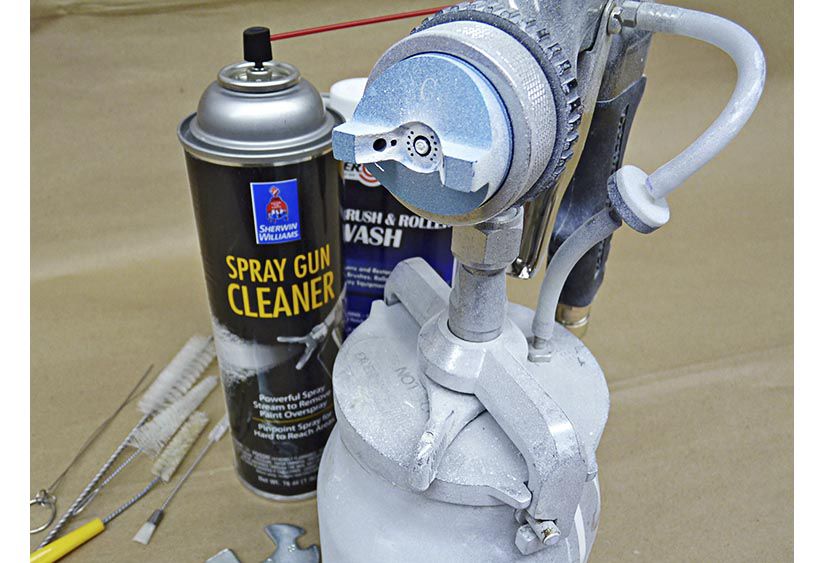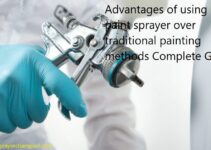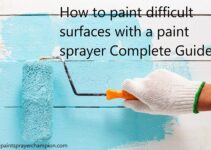Do you have a Paint Sprayer but don’t know how to properly clean and maintain it? With this guide, you’ll have all the tricks and tips you need to keep your paint sprayer in optimal condition.
Let us explore the easy yet effective ways of cleaning and maintaining a paint sprayer like a pro!
Cleaning and maintaining a paint sprayer is not difficult, but it must be done regularly to ensure the best results and longevity of the product. There are three main steps to properly cleaning and maintaining your paint sprayer: cleaning the cup, flushing out solvent, and storing the machine properly between uses. In this guide we provide detailed instructions to help you get familiar with the process of properly cleaning and maintaining your paint sprayer for optimal performance. Following these instructions will make sure that your equipment lasts for years of effective use.
Explanation of airless paint sprayers
Airless paint sprayers are a popular choice for professional painters to get the job done quickly and effectively. They use a powerful motor and piston system to draw paint from a bucket, break it into tiny particles, and force it through a fine-tip nozzle onto any surface. This allows painters to achieve an even coverage of the desired material over much larger areas than those achievable with a brush or roller. However, because they often require frequent refilling, they can be prone to clogs if not maintained properly. To ensure optimal performance and prolong the life of your sprayer, regular maintenance is essential.
Paint sprayers consist of three main parts: an air compressor, an airless pump machine, and the gun with nozzle or tips. The compressor compresses air that is then sent through an airless pump which forces paint through the tip of the gun at high pressure (most machines range from 2500-4500 psi). This high pressure atomizes the paint into tiny droplets that can provide more even coverage over large surfaces than if applied manually. Properly maintained airless machines typically last up to two decades if used correctly and following regular servicing guidelines.
Recommended practices for using an airless sprayer include verifying fluid flow before beginning each application session, rotating crafts often when painting in different directions on one surface, cleaning the gun thoroughly after each job; replacing filters regularly; draining remaining pigment from your material cups following each session; inspecting hoses regularly for leaks or blockages; ensuring proper gas pressure levels; and storing sprayers in cool dry places whenever possible. Following these steps will help ensure maximum efficiency from your equipment while reducing downtime caused by clogs or other problems due to improper use or neglect.

Benefits of using airless paint sprayers
Airless paint sprayers are the highest performing type of paint application method available, since they direct atomized particles at a very high velocity. This means that you’ll get a perfectly smooth, perfectly even finish every time you use one. Airless sprayers also save time, allowing you to paint a surface in a fraction of the time it would take with other methods.
Using an airless paint sprayer is also more efficient, since you can adequately cover surfaces with fewer coats of paint, in less coats than brush or roller applications. This means that not only will you be able to achieve beautiful results faster and with less effort, but with the same amount of product — that’s excellent value for money!
Airless sprayers also provide precise coverage for corners and tight areas, creating edging that looks professionally done every time. With their powerful droplet size and precise control, airless sprayers offer control and accuracy not available with any other type of painting system.
Importance of understanding how they work and when to use them
Using a paint sprayer is a fast and convenient way to apply a professional finish to many do-it-yourself projects. If you plan to make use of this type of equipment, it is important that you gain a basic understanding on how they work and when it is best to use them.
Different types of paint sprayers can be used in various situations depending on the specific application requirements for the project. The most common types of paint sprayers are those used for high pressure spray applications, airless systems, and fine finish tools. Each offers different advantages depending on the type of project or job that needs to be completed.
High pressure spray applicators use compressed air or gas to force out liquid material through a nozzle attached to the machine. They are most often used for larger, industrial scale jobs where quick setup times are vital. Airless systems use centrifugal force from an electric motor located at the base of the machine in order to generate up to 3 times more pressure than traditional high pressure systems. This makes them ideal for larger tasks where speed and greater coverage is required compared with their mechanically operated competitors. Lastly, fine finish tools are designed specifically for activities such as painting furniture or detailed objects that require accuracy over strength and power but still need great coverage in one coat finish result.
Knowing which type of painter device to utilize should be determined by understanding what exactly will need done and what level of precision is necessary along with other parameters like cost efficiency and environmental appropriateness when compared against other technologies and methods options available out there today in 2021.
Components of airless paint sprayers
Airless paint sprayers works on a pressurized system that comprises certain key components which help to deliver a demanding and effective performance. Below are the key components of airless paint sprayers that function together to create a perfectly fine finish.
- Pump – The pump is responsible for pressurizing the paint supply and spraying it through the gun or hose of the airless sprayer. Different types of airless pumps are available, each designed to work with specific viscosities of paint, stains, etc., ensuring your job/task runs smoothly.
- Filters – These are responsible for providing clean, wood pulp-free, gelled-out primer removal free outcome by filtering all contaminants out before they can enter into the pump or spraying system. Spray gun filters sit at the top of the gun just after where the hose connects and downstream filters live in line between where your hose connects to your pump/motor assembly and your spray tip assembly fitting below that pointing downwards into your pressure hose line.
- Pressure Control – This component helps to ensure consistency in delivery as pressure needs to remain constant throughout each pass/coat when spraying in order for an even finish result every single time no matter what you’re spraying on it whether it’s metal roofs or automobile carpets etc., for example, thicker materials like latex paints which require high pressures vs lacquers which require mid-range pressures .
4 Hoses – The hoses ensure consistent pressurization from tank to painter and helps avoid any potential clogging within an individual stroke while also safeguarding against accidental damage while outdoors such as dragging heavy equipment over them and other hazards related when working away from regular shop settings such as clover burs getting caught up inside hose fittings connecting two pieces metal items together or even tooth bits were used when cutting metal.
Pump
Regular maintenance and cleaning of your pump will keep your paint sprayer in top working order. Here are a few easy tips to ensure that your pump stays in good condition.
Before you start, make sure to check for any visible signs of damage on your pump. The seals, gaskets and O-ring should be kept clean and replaced if needed. Inspect the lubrication level of the motor bearings and gearbox, as any inadequate lubrication can lead to brief periods of low or high pressure and result in a sprayer malfunction.
At the end of each spraying day, it is important to disassemble, clean and flush the interior parts of the pump with fresh paint thinner or water. Some manual pumps require a special tool for this process; however this should not be done in an enclosed area as solvents contained within paints may be harmful if inhaled or come into contact with skin or eyes. Cleaning all components of the paint sprayer will ensure that no build-up is left which could cause malfunctioning during future use.
Hose
Hoses of a paint sprayer are vulnerable to dirt and other particles which can accumulate over time and cause blockages in the nozzle or suction tube. It is important to inspect the hose for any build up or debris after each use to avoid having to replace it.
To clean the hose, you should use a compressed air source such as a compressor or an air gun. Start at the furthest end working towards the sprayer. Make sure to maintain a distance of about 4-6 inches between the nozzle and hose during cleaning to ensure that no damage is done by the force of air on the hose walls. Once you have finished cleaning, wipe down any excess moisture away with a rag. If needed, you can also use a mild soap and warm water solution if needed, before drying with a towel.
Regular maintenance will help increase overall life expectancy of your paint sprayer’s hose while reducing clogging and other performance issues that may arise due to lack of proper care.

Spray gun
Spray guns are used in many painting projects and can provide precise, uniform coverage if properly used. Like any other tool, a spray gun should be properly cleaned and maintained to get the best performance from it. Cleaning a spray gun is relatively simple and just requires soap, water and a few other supplies. Taking the time to clean the gun after each use can help ensure you achieve the desired results with each job.
The first step in cleaning a spray gun is to disassemble it so that all of the parts can be individually cleaned. Remove any residual liquid/paint still remaining in the cup as this can easily dry on surfaces making cleaning more difficult later on. Next, remove all of the gun parts and place them into a container filled with warm soapy water. Cleaning solution may also be used if needed but should always be checked first to ensure it won’t damage any of the materials used in your sprayer. After soaking for several minutes, scrub all of the components using an appropriate brush or cloth then rinse each piece with warm water before drying thoroughly.
Once dry reassembly of your spray gun is complete make sure that all pieces fit tightly together before using again to ensure safety and proper operation during painting tasks. In addition regular maintenance like changing out nozzle tips or filters regularly as recommended by manufacturer guidelines should also be performed at least once per year for optimal performance from your paint sprayer.
Tip
It’s important to keep your equipment in good condition, especially when it comes to a paint sprayer. Proper maintenance and cleaning of the machine should be done after every project or on a regular basis. Here are some tips for ensuring your paint sprayer is running properly.
-Remove excess paint from the nozzle after each use. Use a soft cloth or brush to remove excess paint from any corners and crevices of the nozzle or other parts that contact paint to avoid clogging.
-Regularly inspect hoses and tubing for signs of cracking, leakage, and other damage. Replace parts as needed to prevent potential problems from occurring down the line.
-Check for clogs and blockages in the hose regularly by running a brush through it, making sure to reach all areas that come into contact with paint or solvents.
-Clean out any leftover residue from inside the container by rinsing it thoroughly after each use. To prevent buildup, add 1 cup of white vinegar per gallon of water and let sit overnight before rinsing in hot water with mild detergent and drying completely.
-Check moving components, such as pistons and actuators within the machine on a regular basis and lubricate if necessary. Replace worn or damaged components if needed.
Following these steps will help ensure that your sprayer operates correctly without having any major issues down the line caused by improper maintenance or negligence.
How airless paint sprayers work
Airless paint sprayers use a piston-driven pump to atomize coatings into tiny droplets. The pump gives the operator precise control over how much coating is sprayed, enabling a very even and smooth finish. An airless paint sprayer pushes the material from a reservoir at high pressure through the spray nozzle, meaning that you don’t have to thin the material before spraying it. The speed at which you are able to complete any coating project can be greatly reduced by using an airless paint sprayer compared with traditional methods of application such as rolling or brushing. This makes it an ideal choice for large area painting jobs or commercial applications.
The heart of any airless paint sprayer is its pump, which works like a syringe to pressurize and force fluid out of a nozzle. Before the actual flow of liquid through the pump can begin, the trigger must first be pulled and held down; this triggers some internal components within the unit allowing high pressure atomization. The more you pull down on the trigger switch, the faster and more intense your atomization will be; different manufacturers will rate their units differently but usually pressure starts at 1500 psi and may go as high as 3300 psi depending on model size and application requirements. As you pass over area being coated with your airless paint sprayer, an even coverage pattern is achieved by combining pressure levels with RPM speed control settings; continuous variable speed control which ranges from 0-3000+ rpms enables you to customize your finishing performance when used with different types of coatings in various environments.
Explanation of the pump mechanism
To ensure your paint sprayer is working correctly and stays in top condition for a long time, it’s important to understand the key components of its design. A paint sprayer is an apparatus powered by either pressurized air or an electric motor that causes a nozzle to emit a steady, powerful stream of paint. The pump mechanism is responsible for moving the paint into the gun and through the nozzle, allowing you to achieve even coverage with large surface areas quickly.
The pump mechanism consists of four main parts: the fluid pump section, the fluid pressure regulator, the fluid filter, and the air intake. The fluid pump works by forcing liquid through small passageways in order to generate pressure capable of spraying paint at high speed. The pressure regulator reduces any excess liquid passing through this pump so as to not cause any damage or overspray due to excessive pressure. A filter located inside the fluid section helps prevent dirt and other particles from entering your system, which could otherwise cause mechanical issues or clog up your nozzle; it should be cleaned regularly for optimal operation. Lastly, air intake enables a constant flow of air from outside sources such as a compressor unit which helps keep your sprayer running smoothly.
Process of spraying paint with an airless paint sprayer
Spraying paint with an airless paint sprayer is a great way to apply a professional quality finish to a surface. It requires careful prep work, clean-up and maintenance, but can provide excellent results in less time than brush and roller applications. To ensure a successful project, follow these steps when spraying:
- Prepare the area for painting by preparing the surface for paint application. This includes removing any furniture or wall hangings, masking off areas that you don’t want painted, inspecting the surface for any cracks or holes which should be filled with spackling or putty prior to painting, cleaning the surface thoroughly with appropriate cleaner and detergent (such as TSP), and sanding any glossy surfaces to give them an even texture prior to spraying.
- Set up your project area correctly according to manufacturer instructions before beginning your project. This includes securing your ladder on even ground in preparation for higher work surfaces, covering any items you want left behind with plastic sheeting, readying buckets of water in case of unfortunate splatters onto surrounding materials while painting and setting up drop cloths around the perimeter of your workspace.
- Make sure that all tools are clean including nozzles and pipes before commencing mixing and loading paint into airless paint sprayer system’s hopper (paint reservoir). Always take time to read the instruction manual carefully before use so that all safety procedures are followed correctly throughout operation of device.
- Begin by priming your spray gun with paint thinner so as not to contaminate your finished product due clogged nozzles or other debris left behind by previously used paints in system components; this ensures top-performing result from device when it comes time for actual spraying operations on job site or home/ industrials spaces alike. Finally! If applicable make sure pressure relief valve is opened while machine is not being used so no unnecessary stress build up inside unit.
- Once primed, adjust nozzle pressure settings according to the viscosity of the material being sprayed. Keep changing back pressure settings until the right setup according to material specifications found in the user manual. Finally, decant the precise amount needed onto container attached to the hopper after preparation has been made to promote consistency and accuracy during painting tasks. Then turn on the power switch found on the trigger handle located underneath the side handle once the sound indicates the machinery has come to life and verify settings are correct enabling gauge readings set to correct points.
- Spray the test area above the fall. A mist should appear when activating the trigger. Move in steady circles to concentrate on working edges and allow fine particles to deposit first thus maintaining consistent coating thickness over the entire component while simultaneously tracking level coverage across horizontal planes thus achieving the desired finish upon completion.

Conclusion
The most important part of using a paint sprayer is taking care of it after each use. Cleaning your paint sprayer guarantees that it will last longer, and also ensures that you get the best results every time you use it. Following the steps outlined in this guide, ensuring proper storage and maintenance of your paint sprayer, can help to extend its life expectancy exponentially.
Regularly inspect and test your paint sprayer for any signs of wear or damage. Replace or repair worn or damaged parts to avoid any potential hazards when operating the sprayer. When cleaning, do not allow chemicals to build-up in the system, as this can decrease the effectiveness of your paint job and also damage your equipment over time. Be sure to follow all safety instructions outlined in the product’s manual that came with your machine. Finally, if at any point you encounter problems with your device that you cannot solve on your own be sure to contact a professional for assistance.
FAQ’S
How do you maintain a paint sprayer?
Regularly inspect and clean the parts, lubricate moving components, follow the manufacturer’s instructions, and store it properly.
How often do you need to clean a paint sprayer?
Clean it thoroughly after every use, and perform deep cleaning every 3-4 uses or if it’s been sitting for a while.
What is the maintenance of spray gun?
Maintenance of a spray gun involves regular cleaning, lubrication, and inspection of its parts, as well as following the manufacturer’s guidelines.
Do you have to clean a paint sprayer after every use?
Yes, it’s important to clean a paint sprayer after every use to prevent clogging, build-up, and corrosion.
How do you clean a sprayer?
Disassemble the sprayer, clean the parts with water or appropriate cleaning solutions, use a brush to remove any dried paint, and reassemble it carefully.
What is the easiest way to clean a paint sprayer?
The easiest way to clean a paint sprayer is to use a cleaning solution recommended by the manufacturer and flush it through the system until the liquid runs clear.
What are five functions of a sprayer?
Five functions of a sprayer are atomization, pattern control, paint flow regulation, air pressure adjustment, and trigger operation.
What are the 3 parts of spray gun?
The three parts of a spray gun are the fluid nozzle, air cap, and trigger.
What are the important parts of sprayer?
The important parts of a sprayer include the motor, pump, spray gun, hose, filter, and pressure control.
How do you clean a sprayer filter?
To clean a sprayer filter, remove it from the sprayer and soak it in a cleaning solution, use a brush to remove any debris, and rinse it thoroughly before reattaching it to the sprayer.
See Also:
- Best indoor paint sprayer
- Best sprayer for latex paint
- Best professional paint sprayer
- Best paint sprayer
- Best paint sprayer under $100


